In 2021, some young players enjoyed their breakthrough season in Allsvenskan, including Veljko Birmančević of Malmö FF, Williot Swedberg and Akinkunmi Amoo of Hammarby, Edward Chilufya of Djurgården. Apart from these attackers, another young star who impressed everyone was Patrik Wålemark, who became a starter at BK Häcken, scoring nine and making eight assists in 29 league appearances. He was also the youngest player to be involved in 15+ goals in the Swedish top-tier this season, trusted by both Andreas Alm and Per-Mathias Høgmo. All of this has made Wålemark one of the hottest prospects in Scandinavia. The January transfer window saw Wålemark transferred from BK Häcken to Feyenoord.
This tactical analysis is a scout report that details the strengths and weaknesses of Wålemark with game examples and data to show us what kind of a player the Dutch outfit are getting.
Construction of the attack
Häcken were not a team that played with complex positional structure, short passes and retaining a lot of possession. Under both Alm and Høgmo, they could use longer-ranged passes to access spaces behind, given they had good ball-playing central defenders such as Tobias Carlsson and Joona Toivio to execute this tactic.
The first part of the analysis will introduce how Wålemark was involved in the team’s attack. The 20-year-old youngster played several positions this season, including as a right-winger and as a 10 in both a 4-1-4-1 and a 3-4-2-1. This shows his potential and well-rounded abilities to play in the centre and the outside spaces.
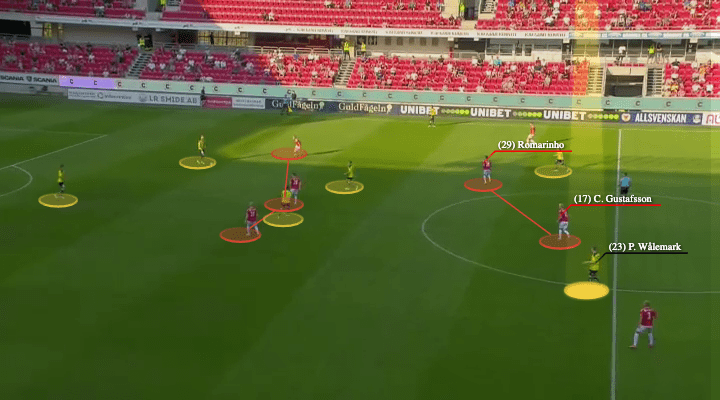
Häcken had good attacking full-backs such as Martin Olsson and Godswill Ekpolo, they often went high and wide in the attack, and the team usually constructed the attacks with four deep players. Regardless of whether the structure was a 3-1 or a 2-2 as shown above, the 10s would be staying high to operate in spaces behind the midfield. Usually, Wålemark did not drop deep to receive outside of the block, as the long passes were not his main trait. He would be patient to wait for the ball to arrive before joining the attack in advanced areas when the team proceeded.
For example, when they played against Kalmar’s 3-4-1-2 defensive shape, with three players in the centre, Häcken smartly placed four midfielders to achieve a “+1” overload. Wålemark was one of the four-man midfield, as indicated here. Instead of staying exactly in the centre, he preferred to lurk just outside the opposition 6 (Carl Gustafsson), which also invited the Kalmar wing-back to follow inside. As a result, more wide spaces would be opened for Ekpolo if Häcken were proceeding through that side.
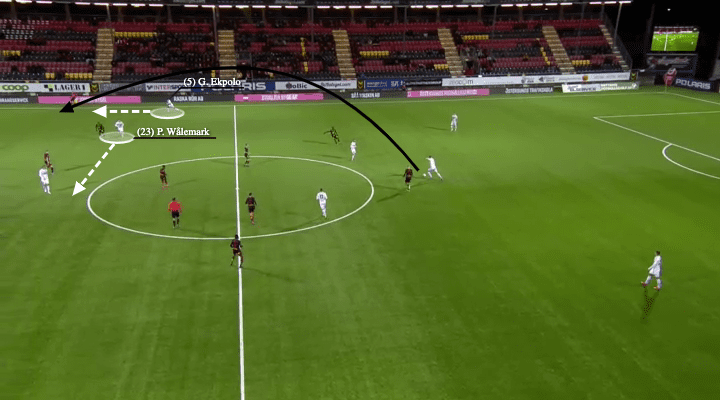
As a right-winger or a 10, Wålemark has a good awareness of his positioning and he used that to bring the right defender in play very well. Against Östersunds FK, he was a 10 in the 3-4-2-1 behind Jasse Tuominen, but he did not stay too inward. Instead, he used his movements and positioning to manipulate the opposition left-back very well, dragging him into the centre to vacate the wide spaces.
The individual movements of Wålemark helped Häcken to attack directly. Here, the central defender dribbled forward and played a long pass. Note that Wålemark, who initially oriented himself towards the left-back, intentionally went lateral infield to fix the attention of marker. Simultaneously, Ekpolo went high and wide to receive the diagonal crossfield ball, and Häcken were into the opposition half.
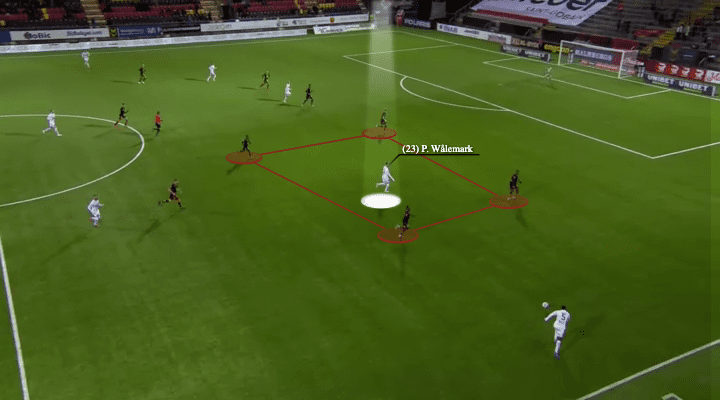
In general, Wålemark is a player who enjoys receiving the ball at his feet, not going into spaces. So, as a winger, his side would be missing some runs in behind on the flank, but the youngster has great positional awareness to free himself from multiple players. In this situation against Östersunds, where Ekpolo had the ball high and wide, Wålemark was in the half-space, but this time he did not attach himself to the left-back. Instead, he was caged inside four players with no one close to him. If the defenders moved, spaces opened elsewhere; if they did not move, then Wålemark could receive the ball well at his feet.
Dribbling and 1v1 flair
Probably, we would see more of Wålemark’s game involvement if he moved to a team requiring more details in the positional attacks. So far, the most impressive part of his game is the ability to dribble and take on the opposition. This section shows the on-ball techniques and talents of Wålemark and explains why he is a dangerous player.
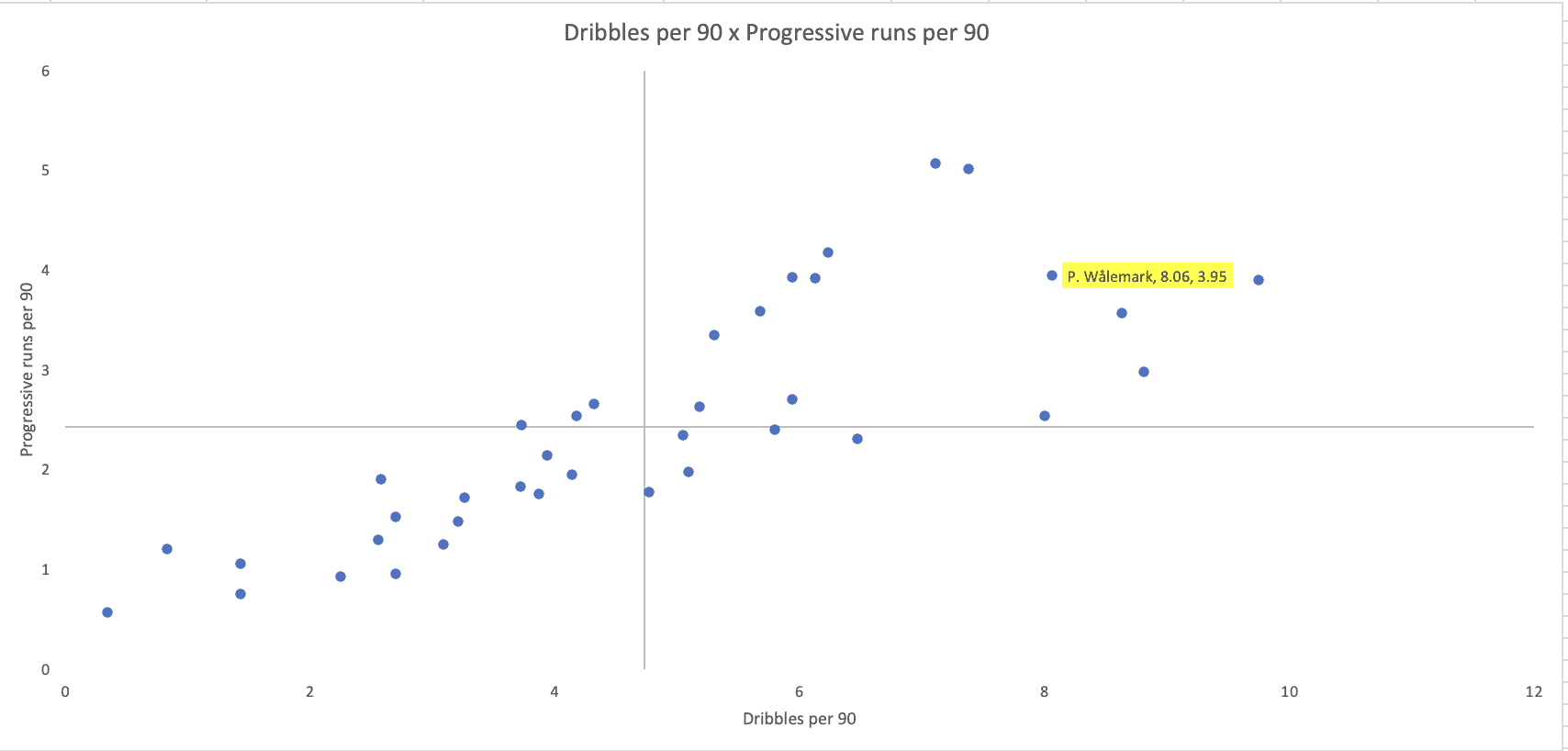
Firstly, we assessed the data of wide players in Allsvenskan to see where Wålemark stands. In the first scatter plot, Wålemark fell on the top-right quadrant, meaning his dribbles per 90 and progressive runs per 90 were both above the average. Furthermore, his 8.06 dribbles per 90 was ranked fourth in the league; he was very eager to take on the opponents. To further evaluate the significance of the dribbles, we estimated his ability to advance the attack for his team by carrying the ball. Wålemark had 3.95 progressive runs per 90, which also ranked fourth, which means he was also able to contribute to the progression of the attack as well.
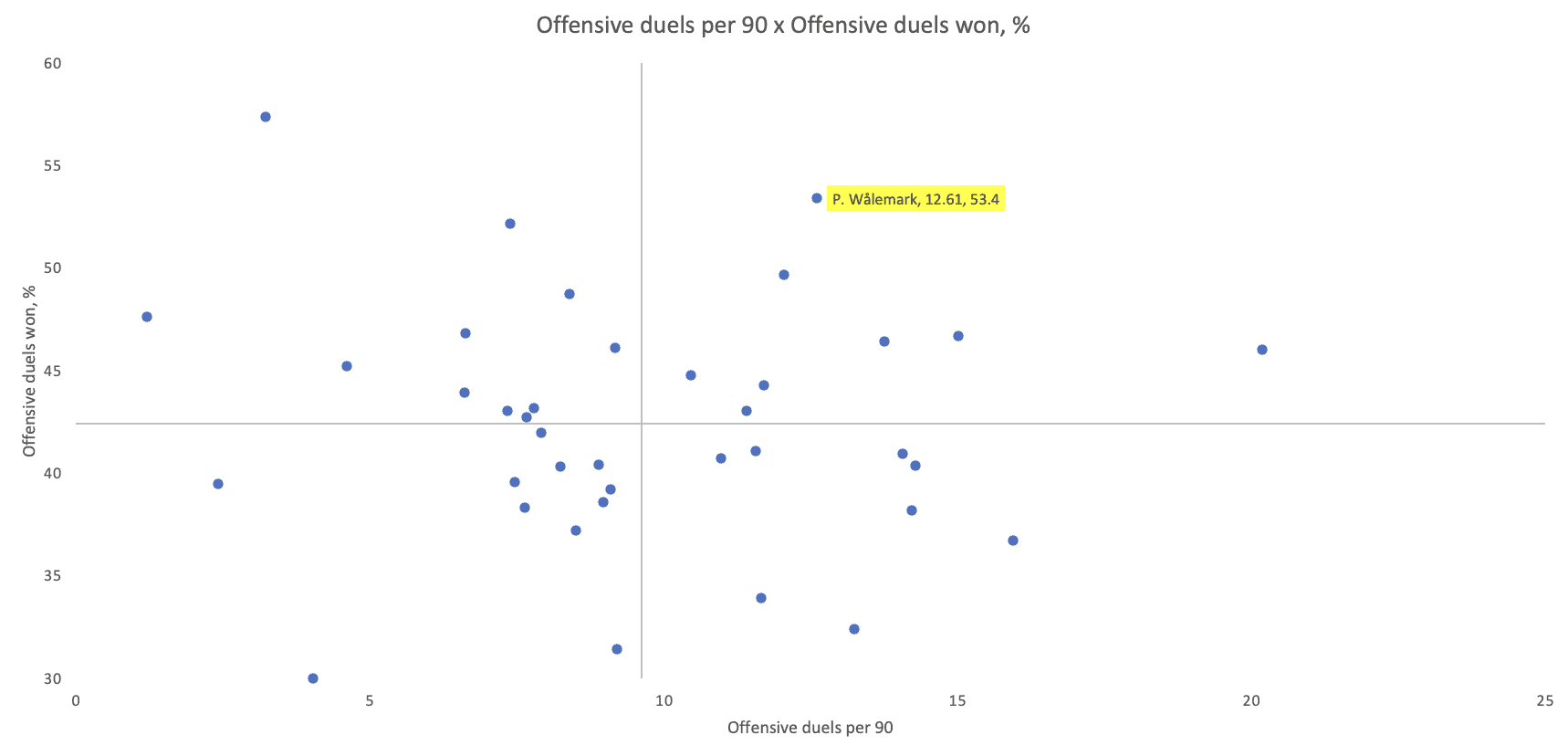
Another metric we used was the offensive duels, which gave us an idea of his ability to retain the ball in 1v1 challenges, as well as how frequently the opposition tried to take the ball away from him. Again, Wålemark was impressive in this area as he had 12.61 offensive duels per 90, which was higher than the mean of his counterparts. Meanwhile, the offensive duels won percentage at 53.4% was outstanding, as only Ari Freyr Skúlason was better than him, but the IFK Norrköping player had far fewer offensive duels than Wålemark.
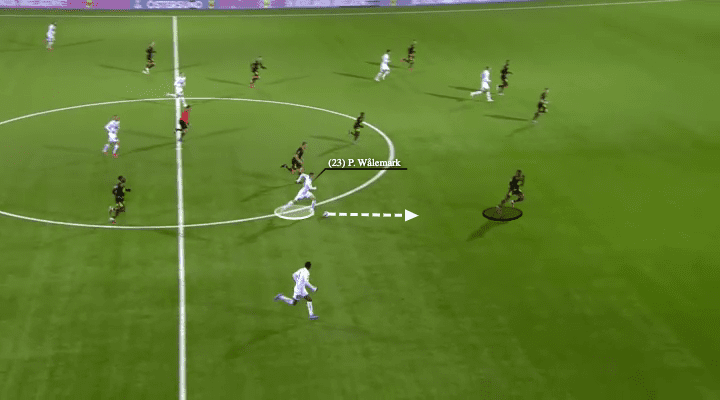
With some screenshots, we tried to picture the special technique of Wålemark’s dribbling. The 20-year-old attacker is different from Chilufya, as he’s not blessed with pace, but his physical gifts make him very special. He has a very great body balancing to allow him to make successive touches on the ball when carrying, this good coordination helps Wålemark to change the direction of his dribble slightly, and the agility is useful when his opposition commits to one way so Wålemark could knock the ball to the other side.
In this situation against Östersunds, Wålemark began the dribble after collecting in the centre of the pitch. The first defender he faced was Patrick Kpozo. Initially, Wålemark was driving the ball a bit vertically towards the left-back.
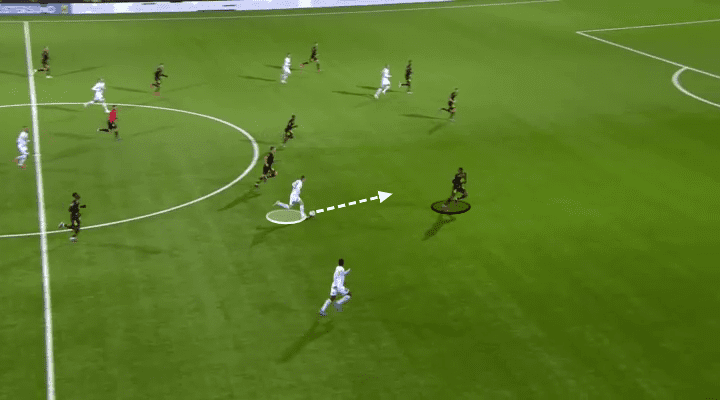
When he was closer to Kpozo, the Östersunds left-back was more facing to the flank as Ekpolo was also there. With the help of the Häcken right wing-back, the attention of Kpozo was distracted and Wålemark slightly adjusted the path of his run, by using the outside of his boot to shift the ball to the diagonal space. Kpozo was eliminated in the defence as his body angle hindered his defensive action and he could not go back to the centre in such a short time.
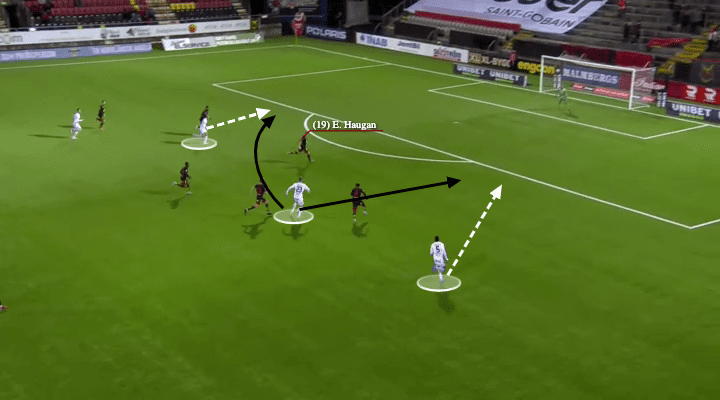
As a result, Wålemark was in the centre with a wider angle to play the ball and more options. For example, he could still release Ekpolo as Kpozo was off-balance already, that was the easiest option but the right wing-back was yet to access that space. A slightly trickier option was to slice the ball to Tuominen, who made a run through the outside space of Eirik Haugan. However, Wålemark did not release his teammates.
The decision-making in the final third needs improvements in general, as sometimes he only has ‘dribbling’ in his head and thus overdoes it, missing the best moments to hit the opposition. If he had a better picture of the game, with his quality on the ball, he would be a greater threat and that aspect could be developed under a proper environment.
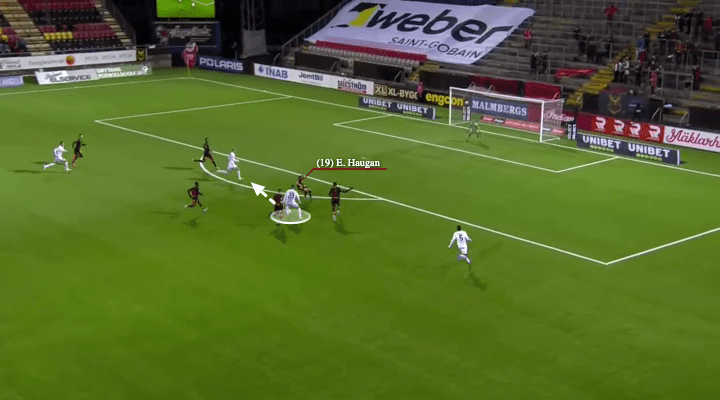
Here, after Wålemark did not release Tuominen and Ekpolo, it was impressive that he did not lose the ball, even though three opponents were closing him. Again, his good body coordination and agility helped him to knock the ball past the defender. This time, Haugan was off-balance as he came from the other side, which you could tell from the image. However, Wålemark had the ball in control all the time and, again, went laterally inward and past Haugan, but that was too late as he could not feed Tuominen.
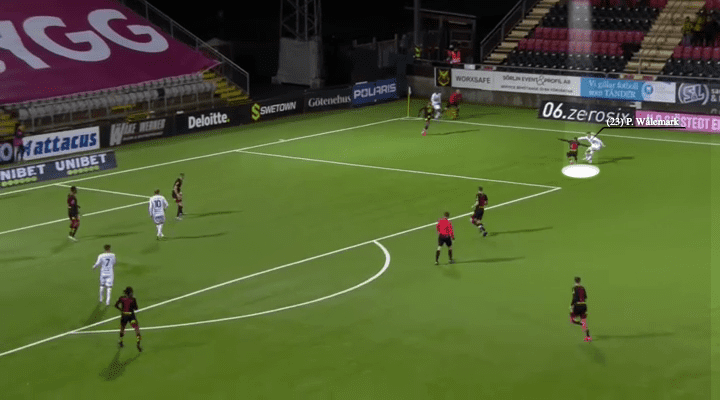
The last image of the section just gives a better picture of how Wålemark checked the ball to space. His strength in dribbling was not only attributed to his physical qualities. Apart from that, he also had good observation on the engaging defender’s body angle. He was patient to wait until the opponent, who usually ran from a farther starting point, decelerated and lost balance. Then, it was the moment to move the ball in the opposite direction. This example shows how he was able to escape from Frank Arhin, once the Östersunds midfielder was overcommitted. Then, Wålemark has the angle to play.
Final third and goal threat
Considering his individual traits and how he’s involved in the team’s attack, we now analyse the role of Wålemark in the final third and how he helps his team to generate goal threats.
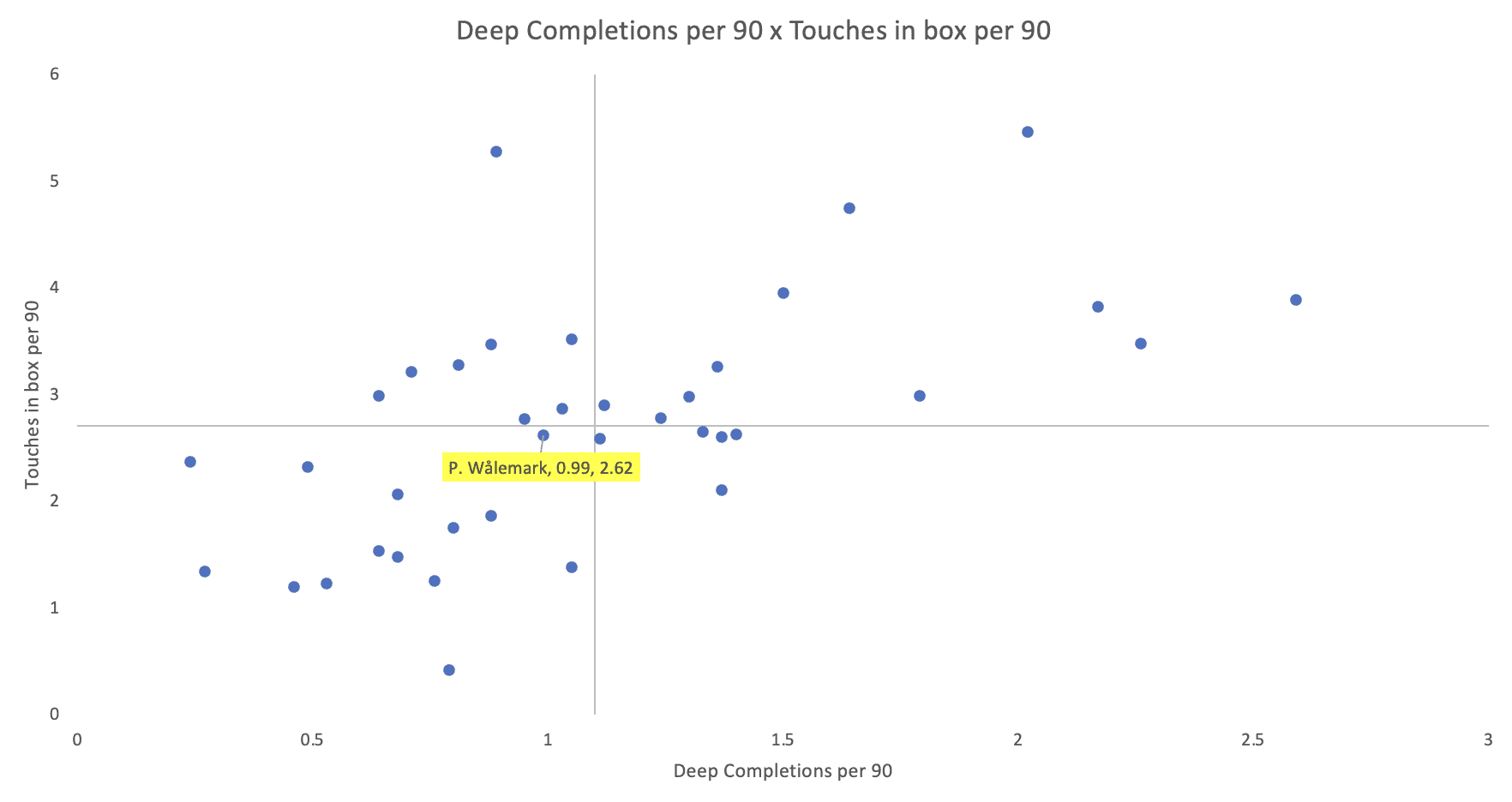
However, based on numbers, he’s not too spectacular in this phase, as he only had 0.99 deep completions per 90. The figure suggests he was not frequently delivering the ball into the six-yard box — not with his crosses nor his passes. Also, his 2.62 touches in the box were not high compared to other Allsvenskan wide players. Both metrics were below the mean because of his playing style.
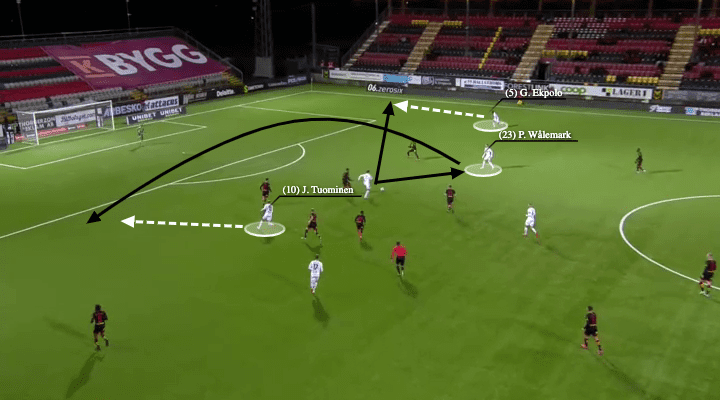
As mentioned above, Wålemark is a player who likes to receive at feet rather than running into spaces. In the final third, he also has the same habit, which might not be favourable when the team needs runs in behind. When the team attacks on the left side, Wålemark is rarely one of the early runners into the penalty box. Instead, he would pause a little bit and wait for the cut-backs more, as the likes of Tuominen and Alexander Jeremejeff would push the last line to the six-yard box.
However, his style of receiving at feet also generated great dynamics for Häcken in zone 14. For example, here, as Leo Bengtsson drove inward, Wålemark stopped and positioned himself between four players again. That posed a question to Kpozo as the Östersunds left-back must decide whether to catch Ekpolo or let Wålemark receive free. If Wålemark received at his feet, he could find Tuominen in the opposite half-space with his left foot but even if Kpozo closed him, Häcken could still reach the byline and produce a cross with Ekpolo’s run.
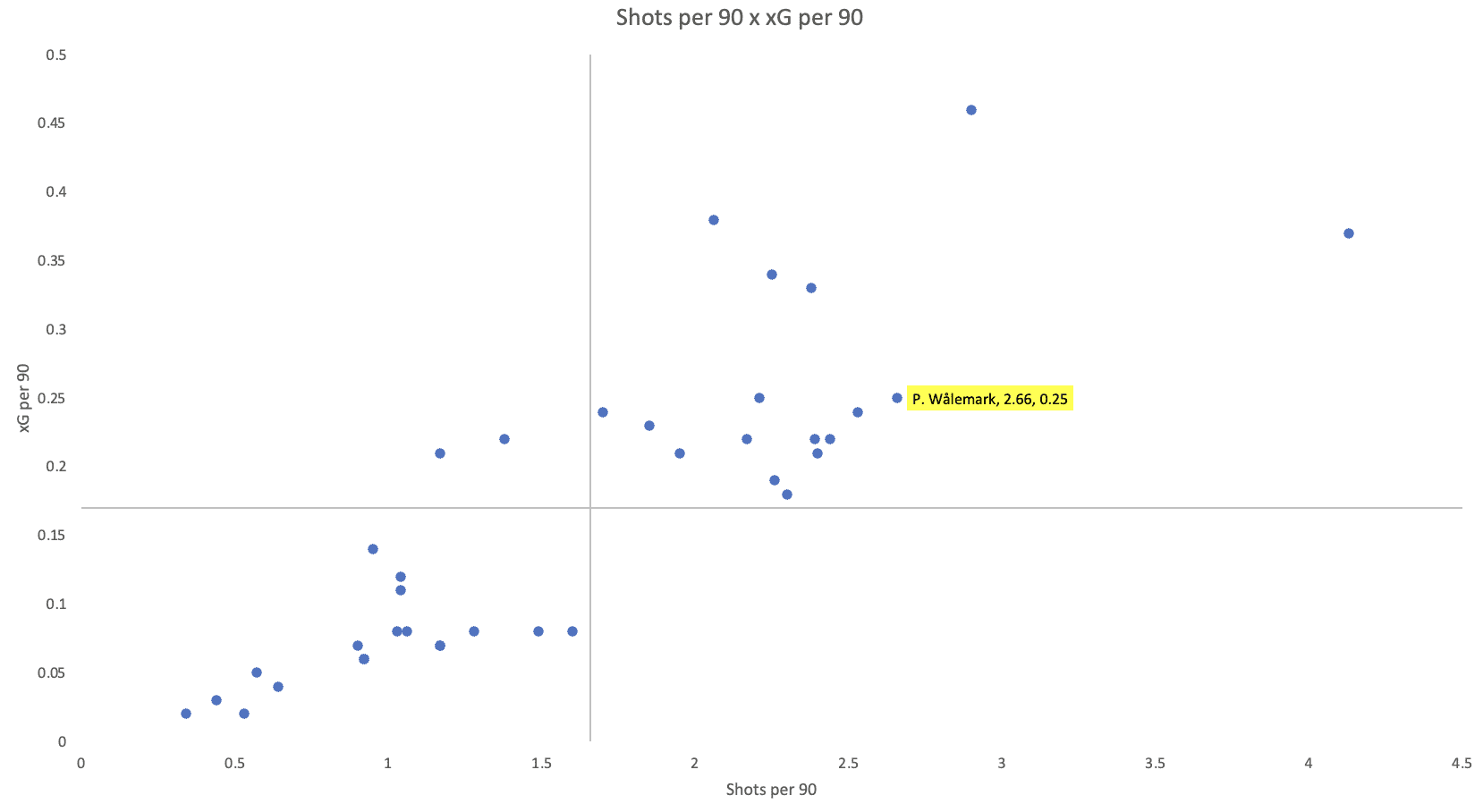
In terms of xG per 90, Wålemark was above the average at 0.25. This figure was a result of accumulated shots throughout a game, as his 2.66 shots per 90 was also above the mean of Allsvenskan wingers, but it was fine as long as the 20-year-old attacker produced the threat to goal.
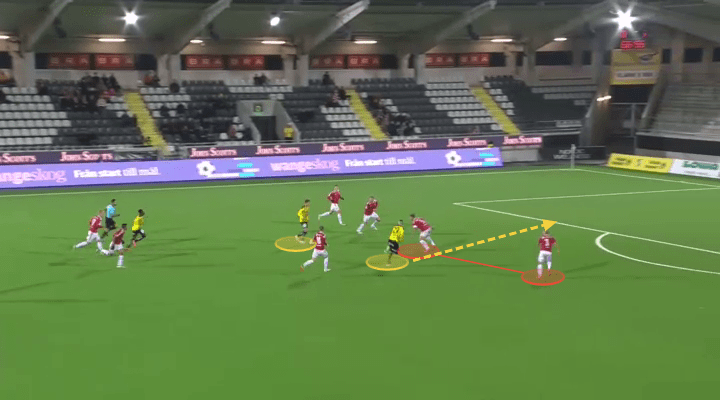
Usually, Wålemark did not run into space when his right-back had the ball but if the attack came from the other side, he would run into the gap between the left centre-back and left-back, as his starting position was usually on the inside. This was how he scored against Degerfors. In a short distance, he still had the pace to beat the defender(s) since his timing to start the run was often earlier than the defenders.
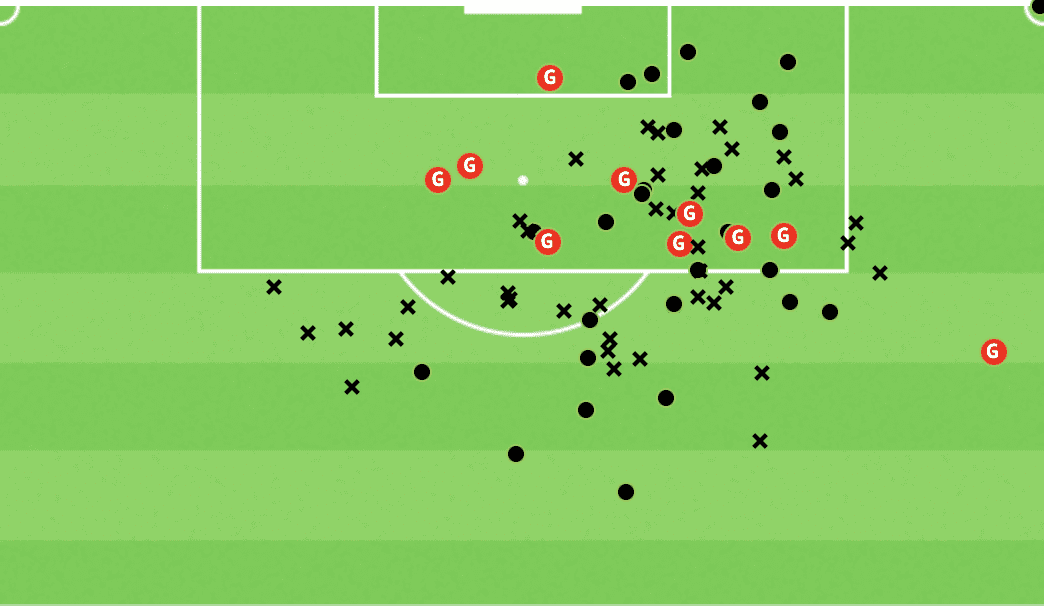
If you see the shots map, the strength and goal threat of the player was very notable. Wålemark, as a wrong-footed player on the right side, has good quality to find the net on the right side. He had several curling efforts that ultimately hit the back of the net this season, and that “assist zone” in the right side of the penalty box was his preferred area to pull the trigger. He shoots in this region much more often than in the centre, and he mainly scored goals in the box instead of outside the box.
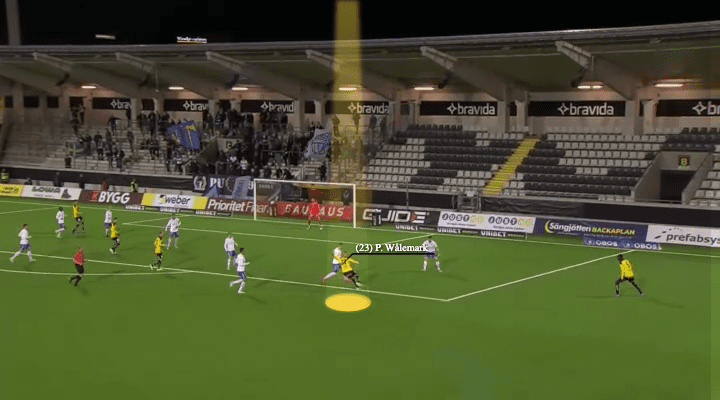
This goal against Norrköping was a fusion of his individual dribbling and shooting skills. It came from a good change of direction after driving the ball towards the opponent who lost his balance when engaging Wålemark at a higher speed. Then, he had the angle for a curler and that went behind the net perfectly.
Rooms for improvement against the ball
Defensively, Häcken were not a very intense pressing team in Allsvenskan, but regardless of how his team played without possession, this is an area in which Wålemark must improve if he wants to push himself to another level.
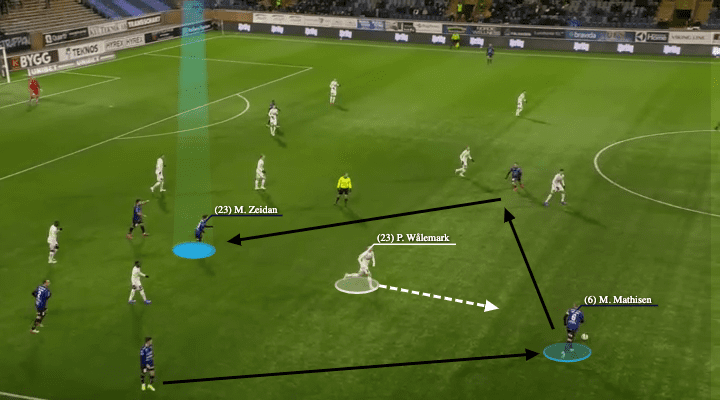
Wålemark’s defending was lacking intensity severely this season; he could not lead the press for the team yet as he mainly used his positioning to cut-off passing lanes. That’s also a reason why he didn’t have too many contacts with the opposition. Another reason for that was Høgmo preferred his best attacker to preserve energy in the attack too.
Apart from the defensive intensity, Wålemark should also improve his decision-making against the ball. Defending is a collective action of the team and he needs to cooperate with teammates more. Too often at Häcken, Wålemark reacted and chased for a backward pass without considering the position of teammates, the distance to travel, and the possibility to access the receiver. When he jumped, he conceded spaces behind, and the opponents were using that to proceed the attack.
For example, in this scenario against Sirius, he pressed Marcus Mathisen without adequately checking the availability of teammates. It was a reckless decision as he was never going to reach Mathisen because of his deep starting position. Consequently, he left Moustafa Zeidan behind him, and Sirius just moved the ball to spaces behind Wålemark, beating him with a series of passes. Wålemark must think carefully before jumping out to press, especially as a 10, and that’s why he might be more suitable to start as a wide player instead of playing inside at this stage of his development.
Conclusion
Wålemark is one of the best talents in Sweden and Scandinavia. As the analysis explained, although he is not blessed with pace like Bayern Munich‘s Leroy Sané in Bundesliga or Wolves’ Adama Traoré, his good coordination made him a very special player. More than a year ago, AZ Alkmaar got Jesper Karlsson from Elfsborg, who shone in the Eredivisie this season, this suggested the Allsvenskan could be a pool of talents for teams in the Netherlands. Feyenoord also realized the potential of players from Scandinavia, and they paid €3.25m to sign Wålemark, which made the 20-year-old winger the most expensive signing of the club in 2020/21. We would be expecting Wålemark to produce a high-level performance in the remaining part of the season!

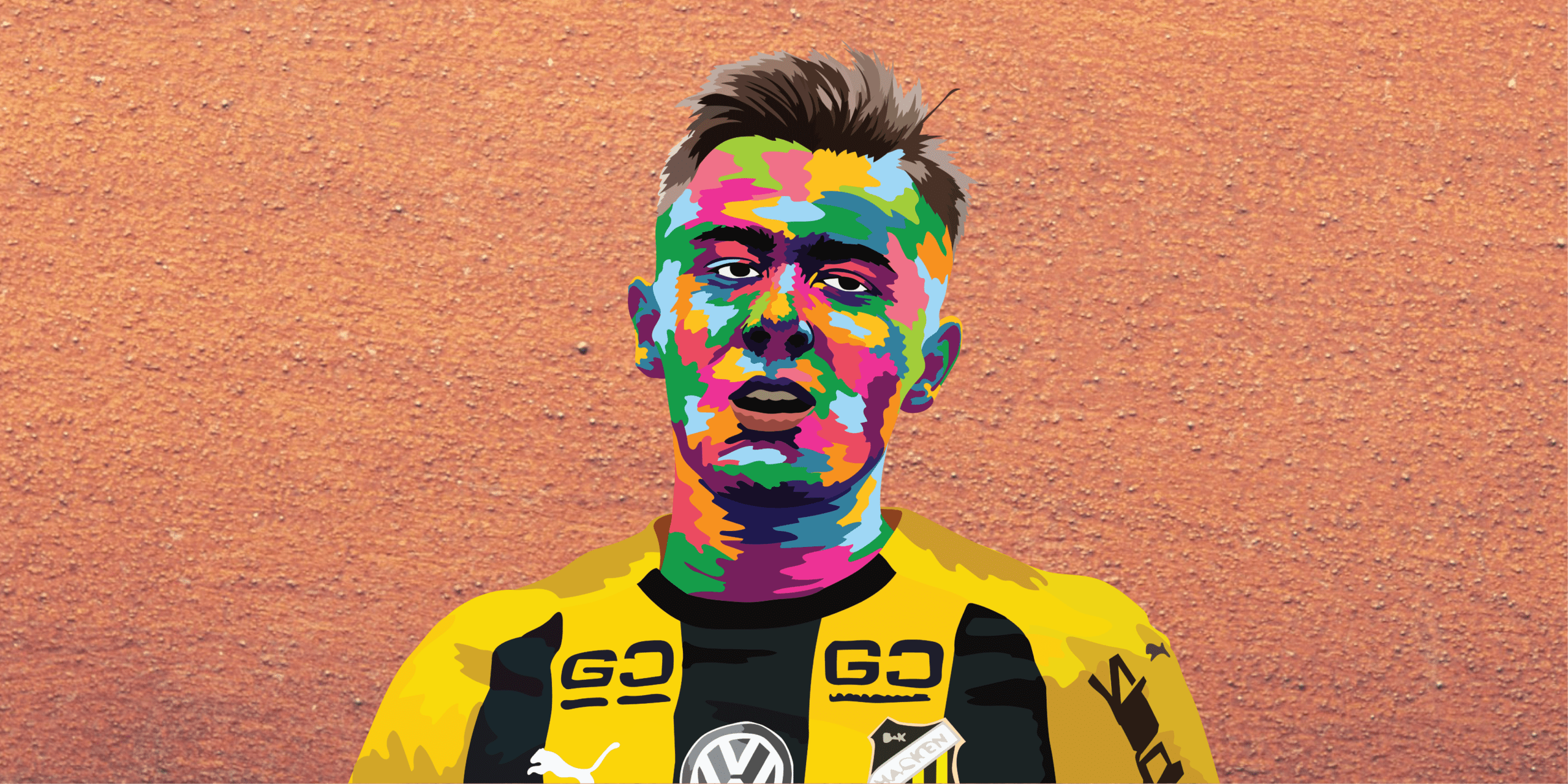



Comments